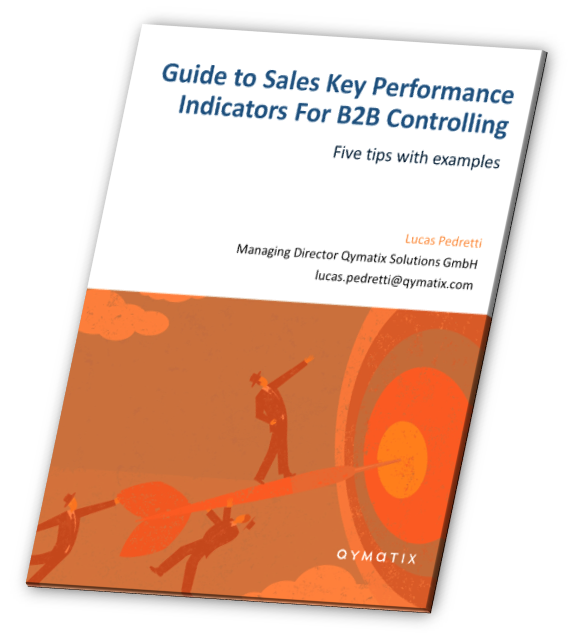How Predictive Sales is Transforming the KPIs You Must Be Measuring

Please enter your Email address
A straightforward question: is your sales team using the same sales performance KPI they did five years ago? If your answer is yes, you better watch out, you might not be using the right KPIs.
Of course, sales per quarter and sales quota attainment are still sensible KPIs to measure. However, total revenues or sales vs quota are lagging indicators. They are “slow KPIs” in the nowadays dynamics B2B sales world. They come way too late.
Keeping track of bookings and orders is slightly better. They measure what happens before the sale. While practical and reasonable, they offer, nevertheless almost no time to react to changes.
Example: discover reasons for customer churn before it happens.
One simple example. Some companies define churn rate, also known as the rate of attrition, as the percentage of buyers who discontinue ordering from them within a given period.
However, why waiting until a customer has stopped buying? Why not contact them beforehand to avoid them from churning?
Regardless of how this churn rate is defined, you can lower it. Evaluate the likelihood that customers will not buy again. Then take steps to avoid this from happening.
You get the logic. Nowadays, waiting is risky and expensive. The B2B sales world is moving faster than ever, and your sales team cannot wait.
Tell me more about Predictive Analytics KPI
This new dynamic requires sales leaders to understand how they are achieving their sales goals. Furthermore, if you want predictable revenue, you need to be extremely pro-active. How exactly do you reach your sales goals then?
Make sure you hire Key Account Managers with the right attitude. Then focus on their behaviour: what they do and how they invest their time. How do you analyse your sales rep’s behaviour? You can measure KPI reflecting the sales activities that they are undertaking.
Measuring the number of sales activities, sales pitches and pipeline KPIs, in general, represents a significant improvement from measuring just lagging sales results or sales bookings.
Sales KPIs related to actions had gained importance in B2B because they consider what happens before the sale took place.
Predictive Analytics has a powerful impact on B2B sales.
It is a known fact that most B2B companies are reaching a plateau in sales productivity. Salespeople are expensive resources, take time to get trained and cannot work 24 hours a day. What is the next frontier of B2B sales? Predictive Analytics.
Predictive Analytics uses a company’s past sales data, statistical algorithms, and machine learning techniques to classify the likelihood of future results.
In particular, predictive sales analytics methods and technologies are game-changing in B2B. For example, sales leaders can meaningfully improve the predictability of their future revenues and customer loyalty using Predictive Analytics.
Remember that Churn software uses Predictive Analytics Methods, applied to customer retention and how to prioritise customer retention activities.
Accurately and consistently calculating the likelihood of fulfilling an expected revenue offers a competitive advantage while increasing customer satisfaction. This enhancement is not possible nowadays, without Predictive Analytics.
From lagging Sales KPIs to Predictive Analytics.
This last thought brings us to the original topic of this article. Are you still using the sale sales KPIs as five years ago? Technology has changed enormously ever since, and to remain competitive, you need to select new KPIs.
B2B sales leaders should evaluate the application of Predictive Analytics methods to their KPIs. There are several examples of predictive sales analytics KPIs and how they can help support a B2B sales team.
How do you get started with predictive sales KPIs? Assess the fundamental questions you need to answer about the future status of your sales situation. Second, review the current KPIs you are using and try to match them with these questions.
Define your critical performance KPIs. Predict them and take actions upon these predictions. Do not wait.
Let me get back to our example. If customer churn is an essential issue for your company, then measure the likelihood of a customer churning, instead of the past churn.
You might need a churn prevention software to calculate this score.
Once you can score the chances of customers churning using a churn prevention software or Predictive Analytics methods, you will be able to extend this analysis to other advanced sales KPIs such as Life-Time-Value of your customer base.
Furthermore, using available Predictive Analytics technology, adopt new KPIs based on the performance questions you have defined. Remember that as with any KPI, less is always more. Focus on the essential indicators for your current challenge.
How Predictive Analytics is Transforming the Sales Performance KPIs you Must Be Measuring – Summary:
Predictive Analytics is the new frontier in B2B sales. It offers a critical improvement in sales performance and is therefore unavoidable.
One key criterion to get started with predictive sales analytics is to define a new set of sales KPIs according to your current challenge. For example, you can relate Predictive Analytics based KPIs to lead scoring, customer churn, and cross-selling, among others.
Sales leaders can get started with an assessment of their ongoing challenge and sales KPIs. It is their job to integrate new Predictive Analytics based KPIs into their reporting system.
Download free eBook: Guide to Sales Key Performance Indicators for B2B Controlling
The unstoppable digital trend in B2B sales also affects how managers should select sales metrics for successful controlling.
Download the free eBook now.
- We will use this data only to contact you for discussing predictive sales KPIs. You can read here our declaration on data protection.


